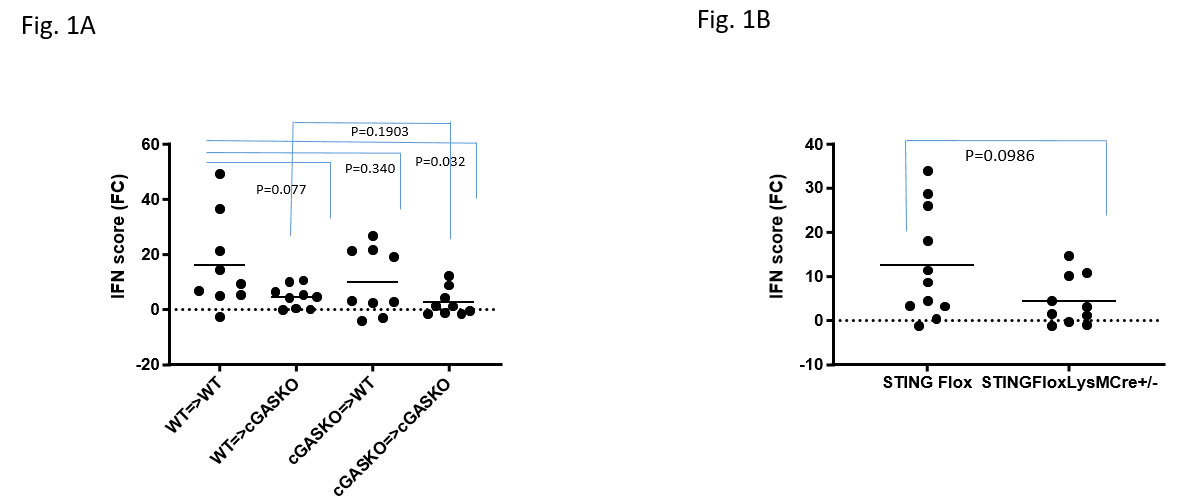Session Information
Date: Monday, November 14, 2022
Title: SLE – Animal Models Poster
Session Type: Poster Session D
Session Time: 1:00PM-3:00PM
Background/Purpose: SLE patients characteristically have a type I interferon (IFN-I) signature in peripheral blood cells and this same signature is prominent in lesional and non-lesional skin. We recently demonstrated that, following a single exposure to ultraviolet light (UVB), UVB induces an IFN signature not only in the skin but also in the blood and kidneys of wild type mice. Since we observed that the IFN-I signature produced soon after UV exposure requires the DNA activated cytoplasmic sensor Cyclic-GMP-AMP (cGAMP) Synthase (cGAS), we asked which cells (skin or immune) are responsible for IFN-I production following UVB exposure?
Methods: Skin was exposed to a single dose of UVB (500 mJ/cm2) and biopsies taken before and at 24 hours after UVB exposure. mRNA expression of interferon stimulated genes (ISGs) and other inflammatory cytokines were measured by qPCR. The IFN score was derived from ISGs as previously described. Reciprocal bone marrow chimeras with either cGAS KO or Wild Type (WT) donors and recipients were generated to determine whether lack of cGAS in skin cells or immune derived (bone marrow) cells are most important in the IFN response to UV. Conditional STING KO mice were generated where STING was knocked down /out in myeloid derived cells by crossing LysM-Cre to floxed STING mice. Statistical significance between groups was determined by unpaired/paired t-test where appropriate.
Results: In 3 separate bone marrow chimera experiments with a total of 9 recipients in each group, the cGAS KO- >cGAS KO chimeras had a significantly lower IFN Score in the skin following UV compared to WT- >WT (p=0.032) (Fig.1 1A). While there was little difference in the mean IFN Score in the cGAS KO- > WT chimera, the WT- >cGAS KO chimera had a 4-fold lower IFN score (mean 4.58) compared to WT- >WT (mean 16.12). In conditional STING KO experiments, mice that lacked STING in myeloid cells, produced less IFN-I (mean IFN Score 4.29, n=10) compared to floxed controls (mean IFN Score 13.36, n=11) (Fig.1B).
Conclusion: The bone marrow chimera experiments document the requirement for cGAS in the early response to UVB. The lower IFN score in the WT- >cGAS KO compared to the reciprocal transfer suggest a requirement for cGAS in skin cells (keratinocytes or stromal cells). The lower IFN score in the LysMCre-STING floxed mice compared to control suggest myeloid cells are also required for a full IFN-I response. Whether the results can be explained by the requirement for another nucleic acid sensor such as IFI-16 or that communication between myeloid and skin cells is required for a full IFN response requires further study and will inform therapeutic approaches to prevent UV mediated exacerbations of lupus.
To cite this abstract in AMA style:
An J, Sun X, Tanaka L, Elkon K. The Cellular Basis for Type I Interferon Production Following Ultraviolet Light Stimulated Cyclic-GMP-AMP Synthase Activation in the Skin [abstract]. Arthritis Rheumatol. 2022; 74 (suppl 9). https://acrabstracts.org/abstract/the-cellular-basis-for-type-i-interferon-production-following-ultraviolet-light-stimulated-cyclic-gmp-amp-synthase-activation-in-the-skin/. Accessed .« Back to ACR Convergence 2022
ACR Meeting Abstracts - https://acrabstracts.org/abstract/the-cellular-basis-for-type-i-interferon-production-following-ultraviolet-light-stimulated-cyclic-gmp-amp-synthase-activation-in-the-skin/

